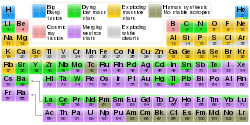Cosmic ray spallation
Cosmic ray spallation is thought to be responsible for the abundance in the universe of some light elements[1]—lithium, beryllium, and boron—as well as the isotope helium-3.
As it turned out, spallation could not generate much deuterium, but the new studies of spallation showed that this process could generate lithium, beryllium and boron; indeed, isotopes of these elements are over-represented in cosmic ray nuclei, as compared with solar atmospheres (whereas hydrogen and helium are present in about primordial ratios in cosmic rays).
The x-process in cosmic rays is the primary means of nucleosynthesis for the five stable isotopes of lithium, beryllium, and boron.
In addition, nuclei of these elements (such as 7Li) are relatively weakly bound, resulting in their rapid destruction in stars and no significant accumulation, although new theory suggests that 7Li is generated primarily in novae eruptions.
This process is now known to occur in cosmic rays, where lower temperature and particle density favor reactions leading to the synthesis of lithium, beryllium, and boron.
[3] In addition to the above light elements, tritium and isotopes of aluminium, carbon (carbon-14), phosphorus (phosphorus-32), chlorine, iodine and neon are formed within Solar System materials through cosmic ray spallation, and are termed cosmogenic nuclides.
